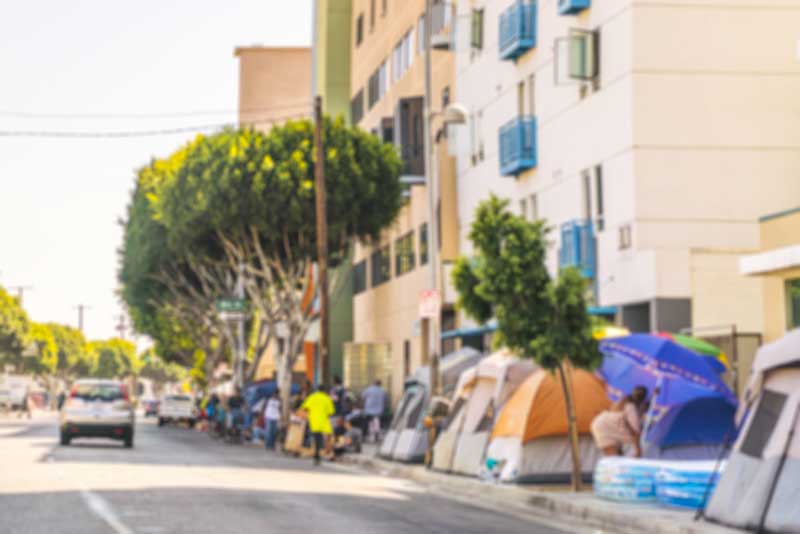
Public Camping Ban
Introduction
More people than ever are experiencing unsheltered homelessness in America. According to annual point-in-time count data, the number of unsheltered individuals increased from 176,357 in 2016 to 233,832 in 2022.1 The Department of Housing and Urban Development estimates that 40 percent of those experiencing homelessness are living outdoors, and 62 percent of the chronically homeless are unsheltered.2 Chronically homeless individuals are individuals with a disability who have been homeless for at least 12 months or have been homeless on at least four separate occasions during three years. Despite the increases in homelessness, there has not been enough done to push unsheltered homeless individuals out of dangerous street encampments and into available shelter space and other services.
The misalignment of the growing unsheltered population with resources to offer them temporary shelter that can immediately remove them from the street has led to a worsening humanitarian crisis and widespread public dissatisfaction. In a recent poll by the Cicero Institute, 66 percent of likely Arizona voters said that homeless encampments on city streets made them feel unsafe.3 A poll of likely Utah voters found that 62 percent of the public sees recovery and temporary shelter as a better response than tax-funded permanent housing.4 Another survey in Oklahoma’s first congressional district yielded similar results.5
Public Safety Risks of Street Camps
The unsheltered homeless population has many grave challenges. The prevalence of crime, mental health and substance abuse disorders, and cyclical incarceration among the homeless population is staggering. In Manhattan, one study found that, between a mentally ill housed person and a mentally ill homeless person, the latter is 35 times more likely to commit a crime and 40 times more likely to commit violent crimes, especially toward strangers.6 The San Diego County District Attorney’s Office found that homeless individuals were 514 times more likely to commit a crime than the average citizen. In 98 percent of cases, a homeless offender is a repeat offender.7
In Phoenix, an area called “The Zone,” which once held 1,000 homeless people, was recently demolished after an Arizona judge called the area a “public nuisance.”8 In Phoenix, there are zero empty beds for the homeless, causing some of the overflow into the Zone.9 The area was plagued with violence and crime. Last year, a newborn baby was found burned to death in the street.10 Drug crimes, disease, and what some have called a “humanitarian crisis” caused the area to be shut down this year.
Roughly half of the people in homeless shelters have been to prison, with one in five having been released within the preceding three years. The University of California at San Francisco found in a June 2023 report that nearly one in three homeless people in California had been to prison or a long-term jail stay in the six months prior to their becoming homeless.11 The same study found that more than 80 percent of people experiencing homelessness reported severe mental health conditions, for which one in four had been hospitalized. Two-thirds reported regularly using hard narcotics like methamphetamine, crack cocaine, and opiates, and less than half of those individuals reported having ever received treatment. Interestingly, only a mere four percent cited high housing costs as the primary reason they became homeless.
Predictably, crime around street encampments is disproportionately high. In 2022, roughly one in four homicides and 15 percent of all violent crimes in Los Angeles involved homeless individuals as either perpetrators or victims, or both. This is especially troublesome given homeless individuals only represent roughly one percent of the population. In Vermont, a homeless encampment was cleared after an occupant fired a gun at a passing school bus full of children, shooting out its windshield. Despite the problems associated with allowing homeless encampments to fester, many cities and states have refused to take serious action.
Health Risks of Public Camps
Homeless individuals are at a higher risk of communicable diseases due to the circumstances of their living conditions. The National Institute of Health (NIH) found that unsheltered homeless have a nearly three-fold increase in mortality compared to sheltered homeless due to a variety of factors, including drug-induced poisonings and infections.12 In 2016–2018, California saw one of the largest outbreaks of Hepatitis A in San Diego County, primarily among the homeless. The outbreak did not affect the general public but did record 465 hospitalizations and 21 deaths. Of those who contracted Hepatitis A, 72% were also reported using drugs. Encampments put homeless individuals at a higher risk for viruses like this because, coupled with unsanitary conditions that allow the virus to spread quickly among inhabitants, they allow drug use to go unchecked.
King County, Washington, recently experienced an outbreak of shigella, an intestinal infection spread by fecal matter. Of the 142 cases reported, 110 were homeless. Tuberculosis, which spreads easily in areas where individuals live in close, unsanitary quarters, has also been found to spread among homeless camps. The NIH found the prevalence of tuberculosis among homeless individuals is 20 times higher than that of the general population. In 2013, a wave of tuberculosis spread among “Skid Row,” a sizeable homeless area in Los Angeles. Sixty of the verified 78 cases were among homeless individuals, and health workers identified nearly 5,000 additional people who were likely exposed.
Camping Ban Legislation
Enforcing a camping ban is a compassionate way to redirect unsheltered homeless to existing shelters that are safer and provide resources such as substance abuse treatment or job placement in addition to hygiene facilities and food. This contributes to better outcomes for homeless individuals and safer communities for all.
The bans, when tied to fines or temporary jail time for unlawful camping on public lands, have been an effective means to addressing the growing homelessness crisis.
Austin, Texas, saw the unsheltered homeless population in its downtown area drop by one-third following the reinstatement of its camping ban in 2021.13 According to federally mandated point-in-time data, the current homeless population in Austin has declined by five percent compared to 2020, consisting of 19 percent more people seeking formal shelter and 20 percent fewer unsheltered individuals.
Georgia recently passed legislation that compels municipalities to enforce camping bans.14 In doing so, the state’s 5,245 unsheltered households will be directed to the 7,302 vacant shelter beds that are currently available, as well as additional temporary options like sanctioned camping facilities.15–16
Missouri’s legislation that compels municipalities to enforce camping bans came into force in early 2023, but its effect on the unsheltered population has not yet been analyzed. What is known, however, is that there are over 6,000 shelter beds available for a total statewide homeless population of approximately 4,800 households.17–18
Utah’s legislature passed a state law compelling municipalities to enforce their camping bans in 2023.19 In doing so, the state’s 780 unsheltered homeless households will be directed to the approximately 2,977 available emergency shelter and transitional housing beds are currently open and available.20–21
Tennessee passed House Bill 0978 in 2022, making it a class E felony to camp on public grounds, which was an extension of state laws to be applied to more general public lands.22 The bill went into effect on July 1, 2022, but its effectiveness has yet to be evaluated.
Colorado Springs banned camping within 100 feet of creeks and other waterways in July 2018. That year, 33 percent of their homeless population was unsheltered.23 By 2022, that number had dropped to 19 percent. Much of the success of this ban has been the ability to relocate unsheltered homeless individuals to shelters that provide various resources like vocational training, food, and hygiene necessities.
Conclusion
To maintain order in our cities, we must hold all citizens, including the homeless, accountable to the rule of law. Removing homeless individuals from unsanctioned camps and placing them in shelters offers them the services they need while reducing crime.
The Zone in Phoenix is a great example of an unsanctioned camp that was allowed to fester without significant law enforcement interaction and have since been shut down. Since clearing the zone, 80% of residents have found more stable shelter.24 Cities should stop these camps before they reach levels similar to the zone, and the best way to do that is to relocate homeless individuals camping on the streets to shelters.

Stay Informed
Sign up to receive updates about our fight for policies at the state level that restore liberty through transparency and accountability in American governance.